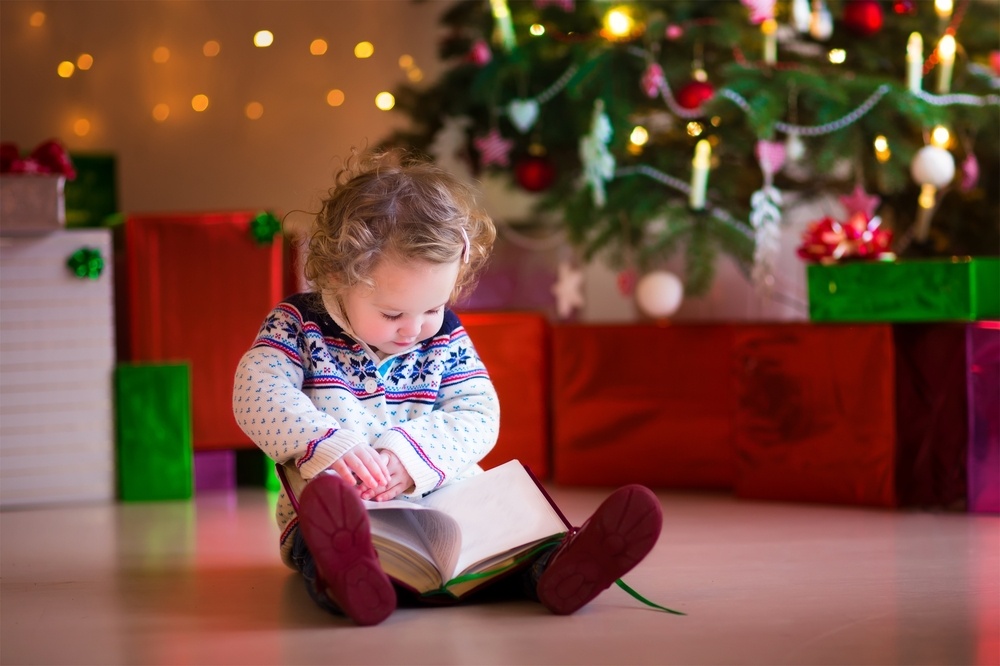Christmas is a magical, fun time for every child. Presents, snow, time off school, and crazy family members—what’s not to love about Christmastime for a child? But with everything being thrown at them, sometimes the real meaning of Christmas gets lost in the mix. Don’t get me wrong, all these things are great, as long as we ensure that our children grow up knowing that Christmas is about Jesus, who was born to save us.
Toddlers may be too young to understand Catholic teachings about Christmas in the way they will later, but that shouldn’t stop you from helping them catch the true spirit of Christmas right now. Here are five ways to do just that—and feel free to leave your own ideas in the comments.
1. Take advantage of liturgical colors
While many think of red and green as the traditional Christmas colors, liturgically the Church celebrates with gold and white, colors which symbolize joy and triumph. (Red and green are typically associated with martyrdom and ordinary time, liturgically speaking—not exactly Christmas themes.) And of course, the weeks before Christmas are marked by violet or purple, and rose.
Exposing your children to liturgical colors from an early age can help them to identify the liturgical seasons and what they stand for. Associating colors with simple feelings like “happiness” “joy” or “being thankful” can help them to realize that we all feel things at different times, and the Church likes to celebrate that with us. During Christmas we use happy colors, because we are happy that Jesus is coming to be with us. So in addition to the red and green this year, jazz up your tree (or maybe even your curtains?) with white and a lot of gold! And if you keep a home oratory or prayer space, change the colors there as well. Eventually, as your toddler becomes a preschooler, she can help with the seasonal changing of the liturgical colors.
2. Read and watch stories about the true meaning of Christmas
Christmas is one of the best holidays for themed children’s books. From Rudolph to the real story of St. Nicholas, there is a book for any form of Christmas you want your child to have. Reading to your child—the power of narrative, of letting the deepest truths of our faith settle in their imagination and percolate in their subconscious—cannot be underestimated. If you read stories to your child about what Christmas really means, they will have a deep love for the birth and gift of Christ. So read stories about the Nativity, St. Nicholas, and other things that are related to the faith. Jessica at Shower of Roses has helpfully listed 35 Favorite Christmas Picture Books for Children.
Even A Charlie Brown Christmas gets at the real “reason for the season.” That’s not to say that your child can’t enjoy Rudolph or Frosty, but don’t let them eclipse the real stories of a Catholic Christmas.
3. Sing (and listen to) Christmas carols!
Toddlers love to sing and listen to fun music, which makes those activities a great way to communicate the true meaning of Christmas. “Jingle Bells” and “Rockin’ Around the Christmas Tree” are great, but many of the classic hymns and carols can be used not only for some fun family time, but to reinforce the faith. Some of our most beloved Christmas carols have very catechetical messages: “O Holy Night,” “Silent Night,” “Away In a Manger”—all tell the story of the Nativity in a way that will be easy for kids to remember.
4. Give gifts—but explain who the real Gift is
I’m sure I have to twist your arm for this one, right? Actually, the key here is to give gifts with context. It’s explaining to your toddler why we give gifts, while encouraging them to give gifts to others. Your explanation might go something like this: “God gave the gift of his son on Christmas, and so we are happy and grateful that we get to have a relationship with Jesus! When we are thankful we like to give back. That’s why we go to Church on Christmas (that’s our gift to Jesus) and it’s also why we give gifts to others.”
Obviously we don’t want to risk Christmas being only about the gifts, but since there’s almost no way to avoid it, and a spirit of giving and gratitude is part of the magic of Christmas, embrace the good this practice have and empower it by doing a simple lesson about generosity.
5. Remember to party!
One of the best things about the liturgical year is that we get to experience all sorts of emotions. During Advent and Lent, we are more somber and reflective, perhaps taking up some penitential practices. But at Christmas, the Church wants us to celebrate.
Of course, for times of celebration to stand out, they need to be surrounded by more ordinary times and practices, not to mention those times of penance and reflection. Make your celebration of Christmas more meaningful by celebrating Advent fully: bless and light your Advent wreath, sing Advent songs, and perhaps even refrain from putting up Christmas decorations until Christmas Eve.
Looking for ways to celebrate Christmas? Here are 21+ ways to Celebrate Christmas to the Fullest with Catholic Traditions.



